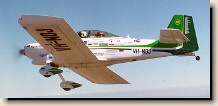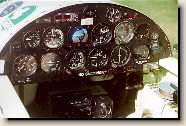|
World
of RVs - Jon Johanson: The Airplane
Jon's RV-4
is a stock airplane, built from a Van's Aircraft kit
exactly to designer Richard VanGrunsven's plans. It had
to be. Australia does not have the equivalent of the US
Experimental category, so each amateur built airplane
has to be inspected and tested to the same standards as
a factory built. No deviations from the plans are
permitted.
 Once
Jon committed to building the airplane, he made steady
progress and finished the project in two and half
years, just under the average completion time for
a Stateside RV-4. Considering Jon's work schedule
(now qualified as a midwife, he often filled in at
local clinics and delivery rooms. Nursing, catching
babies, and flying meant that he often worked 80 hours
a week trying to pay for his airplane....over and
above the time spent building it) this was very good
time. Once
Jon committed to building the airplane, he made steady
progress and finished the project in two and half
years, just under the average completion time for
a Stateside RV-4. Considering Jon's work schedule
(now qualified as a midwife, he often filled in at
local clinics and delivery rooms. Nursing, catching
babies, and flying meant that he often worked 80 hours
a week trying to pay for his airplane....over and
above the time spent building it) this was very good
time.
"Well,
I couldn't afford to take too long. I was paying rent on
the shed I was working in."
Jon was
delighted with the RV-4 and flew it every chance he got.
A couple years later, it took him back to southern
Australia, where he had decided to take a University
degree. The trip across the Australian continent
restarted a certain train of thought that had first
bubbled to the surface in Cambodia....if the RV-4 could
make it across the hugeness of the Australian Outback,
just how far could it go? Over the next year, the
question continued to intrigue him and he spent many
hours deciding just how his airplane could be modified
to carry him to the Mecca of every homebuilder, Oshkosh.
And if the airplane could take him half way around the
planet to Oshkosh, why couldn't it take him all the way
around?
The RV-4 is
an efficient airframe with good cross country
capability, but it was not designed as a world cruiser.
When thoughts of distance flying became impossible to
ignore, Jon started to look seriously at the
modifications that would be required. He realized the
limitations of his airplane, but, of all the airplanes
he had ever flown, this was the one he wanted as his
own, so he decided to use it.
First, there
was the matter of fuel. A stock RV-4 holds 32 US
gallons, and at an economy cruise setting, might be
expected to go 650-700 statute miles. A world flight,
especially one across the southern Pacific Ocean,
demands ranges in excess of 2000 miles. Jon's solution
was several extra tanks. He first converted the stock RV
Fiberglas wingtips into fuel tanks, lining them with a
vinylester resin that was impervious to fuel, and
arranging a simple gravity system that emptied them into
the standard leading edge tank. The space between the
instruments and the firewall was available, so Jon made
a small header tank. These modifications raised the
total capacity to about 60 US gallons, still far short
of the necessary. The only remaining practical place for
fuel was a ferry tank in the back seat. An aluminum tank
was duly fabricated and installed.
Further
range was gained by fitting an electronic ignition in
place of one magneto. The hotter spark and automatic
advance gave an immediate ten percent gain in fuel
economy. A Sensenich metal prop, designed especially for
RV aircraft, was installed. This was essential because
there was the possibility of flying for long periods in
rain and a wood prop could erode dangerously. Good
fortune accompanied necessity and Jon found that this
prop was the most efficient he had tried yet.
 To
communicate, Jon augmented the usual VHF radio with
a HF set transmitting through a long trailing antenna,
retracted by a fishing reel and feeding through a
tube down the right side of the fuselage and out over
the wing root. Navigation was handled by GPS. To
communicate, Jon augmented the usual VHF radio with
a HF set transmitting through a long trailing antenna,
retracted by a fishing reel and feeding through a
tube down the right side of the fuselage and out over
the wing root. Navigation was handled by GPS.
An external
venturi was added as a back up to the engine driven
vacuum pump, and if all else failed, Jon would be
wearing an specially designed life vest containing a
life jacket, raft, ELT, strobe, rations, and dye over
his Nomex suit. The original seat was replaced with a
fiberglass race car seat, carefully padded to fit Jon's
body.
Jon is
careful to point out that every one of these
modifications, as dictated by common sense and the
Australian CAA, was carefully thought out, documented
and thoroughly proven in extensive flight tests.
Even though
Jon lost 22 pounds while preparing the airplane, it was
soon apparent that, with enough fuel to make
ocean-spanning legs, survival gear, communication gear
and supplies, the gross weight was going to be higher
than the recommended 1500 pounds. In the US, where the
gross weight of an airplane in the Experimental category
is determined by the builder, this would have been no
problem. In Australia, it required an approval from the
designer. When Jon contacted Dick VanGrunsven, Van was
initially tempted to dismiss him as another dreamer.
"There
are always a few people who just don't seem to grasp the
fundamentals of what makes airplanes fly or
perform." Van says. "They want to modify them
in completely impractical ways. After I talked with Jon
for a while, I realized that he did understand his
airplane and his questions were good ones. When I
visited Australia, I got a chance to meet him and I was
impressed. If anyone was going to do what Jon was
proposing to do, he was the one." After reviewing
Jon�s modifications and qualifications, Van felt
comfortable issuing a one time approval for a take-off
weight equaling 136% of the recommended gross.
When
modifications were complete, the airplane could stay in
the air for more eighteen and a half hours. At an
economy cruise speed of 140 knots, this provided a still
air range sufficient to make the longest legs against
headwinds and still have an adequate reserve.
When the
airplane was ready, it was time to test the pilot. Jon
considered himself the weak link. He trusted the
airframe and the engine to go the distance, but could he
stay mentally and physically functional during the long
hours in the cockpit? There was only one way to find
out. On December 20, 1994, he made a 9 hour non-stop
circuit of southern Australia and Tasmania, just to warm
up. The next step was something really big.
Jon lives in
Australia. There was a national fly-in in New Zealand.
No piston single engined airplane, let alone a
homebuilt, had ever flown the Tasman Sea between the two
countries non-stop. So..... the flight from Adelaide to
Auckland was accomplished January 29, 1995 in 13 hours
and 57 minutes. Weather played a part -- Jon spent a
couple of hours working his way through a front off the
Australian coast and fought headwinds all the way. His
spirits lifted when he was joined by Kiwis James McPhee
and Gary Spicer, flying their RVs, off the New Zealand
coast and escorted into Auckland. A week later, he
returned, flying a slightly shorter trip from Wellington
to Melbourne...again, headwinds all the way and
groundspeeds down to 87 knots at times.
After the
New Zealand trip, Jon knew he could make the Big One.
Mentally, he was ready. Physically, he could hack it. He
had the right airplane. What he needed was money.
Hoping to
find corporate sponsorship, Jon began knocking on doors
before his flight to Auckland and had found most of them
firmly closed. When he returned to Melbourne from New
Zealand, the media had gotten wind of a good story and
were out in force when he landed. He ended up in almost
every newspaper and local TV station. Some of those
stories ended up being rebroadcast nationally.
Armed with
videos and clippings, Jon set out on the trail of
sponsorship, selling what he had to sell; his record of
success, his own determination and space for sponsor's
logos on his airplane and his flight suit. He eventually
reached a few people who could see the benefit of being
associated with a quiet man who could capture the public
imagination. Garmin came up with a top of the line GPS
unit to augment the one already installed. S-Tec
provided a single axis autopilot -- the initial flights
had been hand flown, which had taught Jon that an
autopilot that could track a heading would be a valuable
aid to a fatigued pilot. Goodyear donated a set of tires
(which may last forever!) The big coup was getting
British Petroleum on board... BP, showing a bit of
corporate fortitude, agreed to furnish the fuel or pay
it in places where BP was not available.
According to
Jon, "That was rough work, selling a dream like
mine to hard nosed types who were, understandably
enough, concerned with their corporate image. But the
thing that really touched me was the small ten and
twenty dollar bits that came from so many regular
people. I had New Zealand dollars, Australian dollars,
and, after Van had returned from Australia and written
about my flight in his newsletter, American dollars,
too. I'm sure some of those twenties were harder to part
with than thousands from big companies..."
Finally,
there was no more that could be done. It was time to
fill the tanks, point the nose east and see what
happened.
|